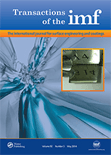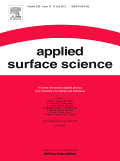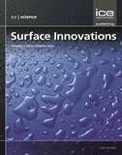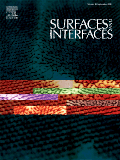
TRANSACTIONS OF THE INSTITUTE OF METAL FINISHING
Scope & Guideline
Pioneering Research in the Science of Metals and Alloys
Introduction
Aims and Scopes
- Electrochemical Processes:
The journal extensively covers various electrochemical techniques used in metal finishing, including electrodeposition, electroplating, and electroless plating. These processes are crucial for enhancing surface properties of metals and alloys. - Surface Coatings and Modifications:
Research on different types of coatings, such as thermal spray coatings, anodization, and sol-gel processes, is a key focus. These studies aim to improve corrosion resistance, wear resistance, and aesthetic qualities of metal surfaces. - Sustainable Practices in Metal Finishing:
The journal emphasizes the importance of sustainability in surface finishing, including the development of eco-friendly processes, reduction of hazardous materials, and recycling of resources. - Characterization Techniques:
Papers often discuss advanced characterization methods for analyzing surface properties, coatings, and materials, which are essential for understanding performance and durability. - Tribological and Mechanical Performance:
The journal explores the tribological behavior and mechanical properties of coated materials, providing insights into their applications in various industries. - Nanotechnology in Surface Finishing:
Research on nanostructured coatings and their unique properties, including self-cleaning and superhydrophobic surfaces, represents a significant area of exploration.
Trending and Emerging
- Advanced Coating Technologies:
There is an increasing focus on novel coating technologies, including nanostructured and multifunctional coatings, which provide enhanced properties such as self-cleaning, anti-corrosion, and wear resistance. - Sustainable and Green Technologies:
Research on environmentally friendly processes and materials is trending, with a significant emphasis on reducing toxic substances in metal finishing and developing sustainable alternatives. - Biomedical Applications of Coatings:
The application of coatings in biomedical fields, particularly for implants and devices, is gaining traction, showcasing the importance of biocompatibility and surface modifications. - Electrochemical Energy Storage:
Emerging studies explore the use of coatings in electrochemical devices, such as supercapacitors and batteries, reflecting the growing interest in energy storage technologies. - Smart Coatings and Sensors:
Research on smart coatings that can respond to environmental stimuli or provide real-time monitoring capabilities is becoming increasingly prominent, indicating a shift towards intelligent materials.
Declining or Waning
- Traditional Coating Methods:
There has been a noticeable decrease in publications focusing solely on traditional coating methods, such as basic electroplating techniques, as researchers shift towards more innovative and sustainable alternatives. - Generalized Corrosion Studies:
Specific studies on general corrosion mechanisms without a focus on novel materials or techniques are appearing less frequently, as the field moves towards more targeted approaches involving advanced coatings and materials. - Conventional Surface Preparation Techniques:
Papers centered on basic surface preparation methods, such as simple grinding or polishing, are declining in favor of more sophisticated techniques that enhance coating adhesion and performance. - Non-Eco-Friendly Processes:
Research involving hazardous materials and processes that do not prioritize environmental sustainability is becoming less common, reflecting the industry's shift towards greener practices. - Outdated Material Systems:
There is a reduction in studies focusing on outdated or less relevant material systems that do not align with current technological advancements or industry standards.
Similar Journals

International Journal of Surface Science and Engineering
Elevating Surface Science to New HeightsThe International Journal of Surface Science and Engineering, published by INDERSCIENCE ENTERPRISES LTD, serves as a vital platform for researchers and professionals in the field of mechanical engineering, surfaces, coatings, and materials science. With an ISSN of 1749-785X and an E-ISSN of 1749-7868, this journal disseminates innovative research addressing the challenges and advancements in surface technologies and engineering practices. Its scope includes, but is not limited to, surface coatings, interface properties, and novel material applications. Since its inception in 2007, the journal has established a solid reputation, achieving a Q3 ranking in Mechanical Engineering and Surfaces, Coatings and Films, and a Q4 ranking in Surfaces and Interfaces as of 2023. These metrics underscore the journal's growing influence, despite being positioned within the Q3 and Q4 quartiles of its categories. The International Journal of Surface Science and Engineering provides a curated collection of high-quality articles that contribute significantly to the understanding of surface phenomena, fostering collaboration and advancements in the field. Researchers, professionals, and students alike will find this journal an indispensable resource for cutting-edge developments and in-depth analyses.

APPLIED SURFACE SCIENCE
Elevating Research in Surface ModificationsApplied Surface Science is a premier international journal published by Elsevier, focusing on the critical advancements in surface and interface science since its inception in 1984. With an impressive impact factor that places it in the Q1 category across multiple disciplines such as chemistry, condensed matter physics, and materials science, this journal serves as an essential platform for researchers and professionals eager to disseminate their findings and explore innovative applications within the realm of surfaces, coatings, and films. The journal's scope includes, but is not limited to, the study of surface modification, nanostructuring, and the fabrication of advanced materials, making it pivotal for those seeking to push the boundaries of applied sciences. It rates highly in Scopus rankings, standing at Rank #22 in condensed matter physics, Rank #5 in surfaces and interfaces, and Rank #13 in surfaces, coatings, and films, underscoring its vital contribution to the scientific community. While open access options are not available, the journal remains a significant resource for academics and industry experts alike, fostering a deeper understanding of surface phenomena and their applications in various technological fields.

Surface Innovations
Advancing Knowledge in Materials and CoatingsSurface Innovations, an esteemed journal published by Emerald Group Publishing Ltd, serves as a crucial platform for researchers and professionals working within the fields of Materials Chemistry, Process Chemistry and Technology, and Surfaces, Coatings and Films. Launched in 2013, this journal has garnered attention for its commitment to advancing knowledge and innovation, holding a distinguished Q3 ranking in multiple categories as of 2023. With a focus on the latest methodologies and applications in surface science, Surface Innovations not only facilitates the dissemination of cutting-edge research but also encourages interdisciplinary collaboration among scientists and engineers. While not an open-access journal, it offers numerous options for accessibility to engage a wide array of audiences, making it a valuable resource for those looking to expand their understanding and expertise in this rapidly evolving field. The journal's consistent inclusion in high-ranking Scopus categories further underscores its academic impact and relevance.

Materiali in Tehnologije
Pioneering Research in Metals and PlasticsMateriali in Tehnologije is a distinguished peer-reviewed journal dedicated to the field of materials science, focusing specifically on metals and polymers. Published by the Institute for Metals and Materials Technology in Slovenia, this open-access journal has been at the forefront of disseminating research findings and innovative technologies since 2000. With a current impact factor that reflects its increasing visibility in the academic community, Materiali in Tehnologije serves as an invaluable resource for researchers, professionals, and students alike, encompassing a wide array of studies in the categories of Metals and Alloys, as well as Polymers and Plastics. The journal is indexed in Scopus, highlighting its relevance and contribution to the field, particularly with its ranks of Q3 in Metals and Alloys and Q4 in Polymers and Plastics. As it converges towards 2024, Materiali in Tehnologije continues to be a pivotal platform for knowledge exchange, encouraging advancements in materials research and technology.

Materials Physics and Mechanics
Exploring the Mechanics of Tomorrow's MaterialsMaterials Physics and Mechanics is a pivotal journal dedicated to advancing the fields of condensed matter physics, materials science, mechanical engineering, and the mechanics of materials. Published by the Institute of Problems in Mechanical Engineering, Russian Academy of Sciences, this journal has established itself as a valuable resource since its inception, particularly from 2003 to 2004 and now continuously from 2009 to 2024. Although it currently holds a Q4 categorization in various disciplines, its contributions are critical to understanding and developing new materials and their applications in engineering. The journal provides insightful articles that explore the nuances of material properties, their behaviors under different conditions, and the physical principles governing these phenomena. Though it operates under a traditional publication model, the insights provided within its pages are invaluable to researchers, professionals, and students striving to push the boundaries of knowledge in the materials domain. Its ISSN numbers (1605-2730, E-ISSN 1605-8119) serve as a gateway to a wealth of scientific knowledge emanating from the Russian Federation, contributing to the global discourse in materials physics and mechanics.

SURFACE REVIEW AND LETTERS
Empowering Researchers with Timely InsightsSURFACE REVIEW AND LETTERS, published by WORLD SCIENTIFIC PUBL CO PTE LTD, is a pivotal journal in the fields of condensed matter physics, materials chemistry, and surfaces and interfaces. With an ISSN of 0218-625X and an E-ISSN of 1793-6667, this journal serves as a platform for cutting-edge research and innovative developments from 1996 to 2024. Despite its classification in the Q4 and Q3 quartiles for various categories in 2023, SURFACE REVIEW AND LETTERS emphasizes the importance of inter-disciplinary collaboration and the rapid dissemination of valuable insights, making it an essential resource for researchers and professionals eager to stay at the forefront of material science. Although currently lacking an open access option, the journal invites a wide range of submissions—fostering knowledge sharing among scholars and contributing to the advancement of the scientific community. Aspiring authors and readers will benefit from the opportunity to engage with diverse studies and methodologies, underscoring the journal's commitment to excellence in materials research.

Surfaces and Interfaces
Connecting Disciplines through Surface InsightsSurfaces and Interfaces is a leading international journal published by Elsevier, dedicated to advancing the understanding of surface and interfacial phenomena across various disciplines, including chemistry, materials science, and physics. With an impressive impact factor placing it in the Q1 quartile for its categories as of 2023—spanning Chemistry, Condensed Matter Physics, and Surfaces, Coatings, and Films—this journal not only serves as a critical platform for innovative research but also reflects the dynamic nature of surface science in contemporary applications. The journal is indexed in Scopus, ranking 25th out of 132 in the Materials Science – Surfaces, Coatings and Films category, marking it in the top 19% of this prestigious field. Although it is not an open-access platform, the journal remains a vital source of curated academic material for researchers, professionals, and students seeking to deepen their knowledge and contribute to ongoing conversations in surface and interface science. Published from the heart of Europe in Amsterdam, Surfaces and Interfaces invites submissions that challenge conventional paradigms and explore the forefront of technology and materials.

Surfaces
Driving Discoveries in Interdisciplinary Surface ResearchSurfaces is an esteemed academic journal published by MDPI in Switzerland, operating as an open access platform since 2018. With an E-ISSN of 2571-9637, this journal focuses on the interdisciplinary advancements in the fields of chemistry, materials science, and physics, particularly in the domain of surfaces and interfaces. As a testament to its scholarly impact, Surfaces is ranked in the second quartile for multiple categories as of 2023, including Chemistry (miscellaneous), Materials Science (miscellaneous), Surfaces and Interfaces, as well as Surfaces, Coatings and Films, showcasing its relevance within these disciplines. Researchers and professionals seeking to disseminate and acquire knowledge on the latest innovations can benefit from the journal's rigorous peer-review process and commitment to quality, ensuring visibility and accessibility for current developments in surface technology and material interactions. With a growing archive from 2019 to 2024, Surfaces stands out as a vital resource for the academic community.

Russian Journal of Non-Ferrous Metals
Elevating Knowledge in Non-Ferrous MetalsThe Russian Journal of Non-Ferrous Metals, published by PLEIADES PUBLISHING INC, serves as a vital resource for researchers and professionals in the fields of materials science and engineering. With a dual ISSN (1067-8212 for print and 1934-970X for online), this journal has been instrumental in disseminating cutting-edge research from 2007 to 2023. Specializing in the mechanics of materials, metals and alloys, and the study of surfaces, coatings, and films, it provides invaluable insights into the latest advancements and applications in these areas. Although currently categorized in the Q4 tier for mechanics of materials and surfaces, and Q3 for metals and alloys in the 2023 rankings, its commitment to quality research is reflected in its Scopus metrics, ranking it within the competitive spectrum of its fields. While not an open access journal, it remains a crucial academic platform for fostering knowledge exchange among professionals and scholars. By publishing high-quality articles, the Russian Journal of Non-Ferrous Metals contributes significantly to the ongoing dialogue in metallurgical science and engineering.

npj Materials Degradation
Championing Open Access for Material Science Advancementsnpj Materials Degradation is a premier open-access journal published by NATURE PORTFOLIO that has rapidly established itself in the field of materials science since its inception in 2017. With its focus on the degradation processes affecting materials and their applications, this journal is essential for researchers and professionals seeking to advance their understanding of the longevity and sustainability of materials. The journal boasts an impressive impact, classified in the top quartile (Q1) of categories such as Ceramics and Composites, Materials Chemistry, and miscellaneous areas of Chemistry and Materials Science, as evidenced by its Scopus rankings where it ranks #17 in Chemistry (miscellaneous) and #27 in Ceramics and Composites. With open access options allowing for a broader dissemination of research findings, npj Materials Degradation serves as a vital platform for the dissemination of innovative research and interdisciplinary collaboration, enhancing the collective knowledge in the ever-evolving landscape of materials engineering and science.